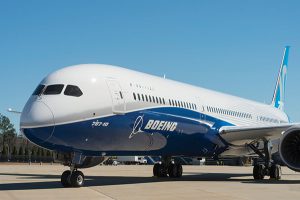Bloomberg
Boeing Co said it’s not racing to resume deliveries of its 787 Dreamliner as the company played down the risk that customers waiting for the jet might switch to rival planemaker Airbus SE.
Stan Deal, president and chief executive officer of Boeing Commercial Airplanes, said the company is in talks with all the affected airlines and indicated he doesn’t expect to lose their orders.
“We hope the power of the product is going to get us through,†he said at a media briefing in Singapore ahead of the city’s biennial air show, which starts from Tuesday. “But we don’t take that for granted.†Deal declined to specify when deliveries might restart, adding “we’re not going to rush the process.â€
Boeing in January recorded $5.5 billion in total costs for the 787 Dreamliner, wiping away any near-term profit for the marquee wide-body jet. The 787 program’s profits have been erased as Boeing pays airlines for service they’ve lost because of delivery disruptions.
The Chicago-based company hasn’t handed over any of the aircraft since June as it addresses a series of tiny imperfections on the carbon-fiber jet frames. Costs soared after Boeing determined that it needed to perform a labor-intensive fix involving the doors of the more than 110 aircraft in its system.
Boeing has meanwhile burned through more than $31 billion during a nearly three-year-long slump marked by the grounding of its 737 Max, the Covid-19 pandemic and a spate of quality lapses.
Airbus sees boom in Asia-pacific jet demand
Bloomberg
Airbus SE sees Asia-Pacific needing more than 17,600 new planes over the next two decades as travel rebounds from the coronavirus pandemic and older and less fuel-efficient models need replaced.
About three-quarters of the required jets are likely to be in the smaller category — such as Airbus’s A220 and A320s — the European planemaker said.
Cargo planes will also be in high demand, with air freight set to double in the region by 2040, Airbus said.
“We are seeing a global recovery in air traffic and as travel restrictions are further eased the Asia-Pacific will become one of its main drivers again,†Chief Commercial Officer Christian Scherer said in a statement. Airbus sees regional travel reaching 2019 levels between 2023 and 2025, he said.
While Asia-Pacific was one of the fastest-growing parts of the world for aviation prior to the Covid-19 outbreak, strict and long-lasting border polices have stunted travel.
 The Gulf Time Newspaper One of the finest business newspapers in the UAE brought to you by our professional writers and editors.
The Gulf Time Newspaper One of the finest business newspapers in the UAE brought to you by our professional writers and editors.
